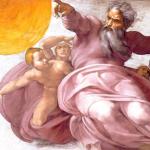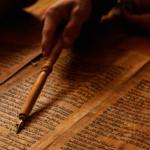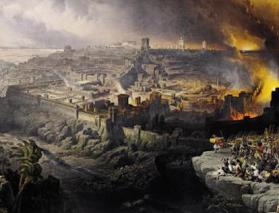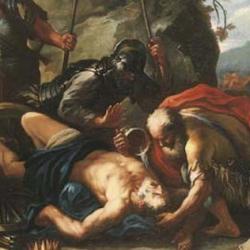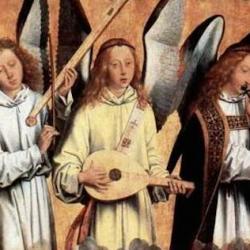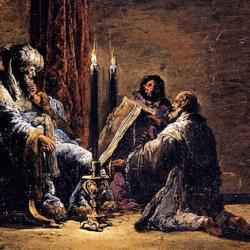The Chronicler recounts Joash’s reign over several chapters, from 2 Chronicles 22:10 through the end of chapter 24. The text is chiastically structured:
A. Conspiracy to coronate Joash, 22:20-23:11
B. Death of Athaliah, 23:12-15
C. Covenant renewal, 23:16-21
C’. Joash repairs the house, 24:1-14
B’. Death of Jehoiada and Zechariah, 24:15-22
A’. Conspiracy against Joash, 24:23-27
The corresponding sections are linked verbally and conceptually, as follows:
A/A’: While Athaliah is destroying the royal seed, Jehoshabeath hides Joash in an “inner room” (chadar hamittot; 22:11). At the end of chapter 24, Joash is killed in his bed (mittah; 24:25). The word can mean “coffin.” At the beginning of the narrative, Joash is secreted away in a grave, from which he will rise to restore the Davidic dynasty; at the end of the narrative, his bed becomes a coffin. The arc of Joash’s story is not from death to resurrection, but from resurrection to death.
More generally, the A and A’ sections are both conspiracies. Jehoiada leads a conspiracy to place Joash on the throne (23:1-11), while Zabad and Shimeath conspire with the servants of Joash’s house to kill him on his bed.
B/B’: Athaliah’s death is recorded twice, first at the end of the the narrative of her death (23:12-15) and then in a closing note at the end of the chapter, which links her death with the establishment of peace (23:21). She is executed justly for her idolatries and murders, and so her death brings rest to the land.
Corresponding to her death is the double death of members of the house of Jehoiada, deaths that plunge Judah back into idolatry and chaos. After Jehoiada’s death, the “officials of Judah” become Joash’s advisors (24:17). These are probably advisors to Athaliah and her predecessors (her husband and son), and so they turn Joash back to the very idolatries that he purged (24:18). The death of bad queen Athaliah led to a destruction of idols; the death of good priest Jehoiada led to a re-erection of idols.
Zechariah’s death also leads to an inversion of Joash’s earlier reign. Zechariah is the son of Jehoiada (24:20). Filled with the Spirit, he rebukes Joash for transgressing Yahweh’s commandments and forsaking Him (24:20). Joash puts him to death – ironically enough, in the court of the temple (24:21), the very place where Athaliah was not executed (23:14). Athaliah dies with an ineffectual cry of “Treason!” Zechariah dies with an effectual prayer, “May Yahweh see and avenge” (24:22).
C/C’: This section might be taken as a single sub-unit, but three things tell against that. First, 23:21 repeats Athaliah’s death notice (cf. 23:15), and brings a close to the narrative of Athaliah’s rise and fall. Second, chapter 24 begins with a formulaic introduction to Joash’s reign (24:1-3), an indication that it is a new section of the text. Finally, C’ (24:1-14) is enclosed with references to Jehoiada’s lifespan: Joash did right “all the days of Jehoiada” (24:2); they offered ascensions continually throughout the “days of Jehoiada” (24:14). 24:1-14 thus hangs together in both content (repair of the temple) and structurally (inclusio).
Though distinct sections, they are related in a variety of ways. Jehoiada leads the people and king in renewing their covenant commitment to be “for Yahweh” (23:16; see here). Being for Yahweh involves, at a minimum, maintaining the temple and its services, which is what Joash does in C’.
As part of the covenant renewal, Jehoiada leads the people in destroying the house of Baal in Jerusalem (23:17); Joash, by contrast, devotes his time and wealth to repairing and maintaining the house of Yahweh. Jehoiada reinstitutes the Levitical orders that David established in the temple (23:18); Joash gives specific attention to organizing the collection and distribution of funds for repair of the house. 23:18 refers to the “ascension offerings” of the temple service, and 24:14 indicates that the priests offered ascension offerings in a restored house.

